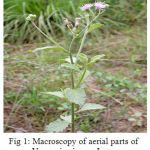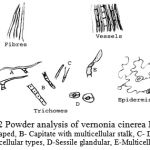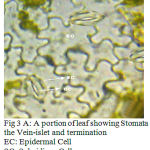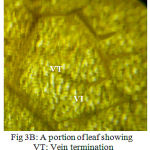Rajshekar M Bhande¹*, P. Kalyani¹, S. Ramachandra Setty², H. Ramesh¹ and K. Sreenivasa Rao¹
¹Department of Pharmacology, RRK’s College of Pharmacy, Bidar, Karnataka India.
²Department of Pharmacology, SCS College of Pharmacy, Haapanahalli, Karnataka India.
Abstract
Vernonia cinerea Less. of family Asteraceae is of medicinal value. In the present study pharmacognostical investigations such as morphology, physico-chemical parameters, powder characters, reaction of powder with chemical reagents and quantitative microscopy are carried out on the leaves of Vernonia cinerea Less. The Preliminary phytochemical screening revealed the presence of Flavonoids, Glycosides, Tannins, and Carbohydrates. The finding may provide useful information with regard to its identification and standardization in future.1
Keywords
Vernonia cinerea Less; Asteraceae; Pharmacognostic; Phytochemical; Leaf constants
Download this article as:| Copy the following to cite this article: Bhande R. M, Kalyani P, Setty S. R, Ramesh H, Rao K. S. Pharmacognostical Evaluation of Leaves of Vernonia Cinerea Less. Biomed Pharmacol J 2010;3(1) |
| Copy the following to cite this URL: Bhande R. M, Kalyani P, Setty S. R, Ramesh H, Rao K. S. Pharmacognostical Evaluation of Leaves of Vernonia Cinerea Less. Biomed Pharmacol J 2010;3(1). Available from: http://biomedpharmajournal.org/?p=1165 |
Introduction
Vernonia Cinerea L. (Astraceae) is an erect annual herb, known as Sahadevi in Sanskrit, Purple Fleabane in English, Garita kammi in Telugu. It also exhibits a wide range of pharmacological effects, including antibacterial (U.K.Mazumdar et al., 2003), analgesic, antipyretic, anti-inflammatory (E.O.Iwalewa et al., 2003), fungistatic effects (G .N. Krishna kumari et al., 2003), hypoglycaemic and anti-diabetic activity ( G.Y.Sy. et al., 2005). It possesses anticancerous activities and is good for cancerous malformations.
Inspite of the numerous medicinal uses attributed to this plant, there is no pharmacognostical report on the leaf constants and other physicochemical standards required for the quality control of the crude drug. Hence the present investigation includes morphological evaluation, determination of physico-chemical constants and preliminary phytochemical screening of different extracts of Vernonia ceneria Less.
Material and Methods
The whole plant Vernonia cinerea was collected from an agricultural land near Chillargi, Bidar, Karnataka. India, in the month of December. The plant authenticated by Prof. Sajansetty, HOD of Botany, B.V.B. College Bidar. India. The fresh plant was used for the study of macroscopic characters and leaf constants, where as dried leaf powder material was used for the determination of ash values, extractive values and phytochemical constituents.
Results and Discussion
Macroscopical characters (Fig 1)
The plant is branched herb, erect or decumbent growing up to 12-75cm high, with a cylindrical, glabrous, slightly branched stem of 10-17cm long, 1-8mm thick. The leaves are simple , alternate, lanceolate, 2.5-5cm long and 1.8-3.6 cm broad .The flowers are pinkish violet, in small heads, acuminate, awned, silky on the back. Fruits are oblong achenes slightly narrowed at the base, clothed with appressed white hairs.
Powder analysis (Fig 2 )
- Numerous anomocytic or ranuculaceous stomata meaning there by that the cells surrounding the stomatal pores are irregularly arranged and cannot be differentiated from other epidermal cells.
- Vessels showing reticulate thickening.
- Fibres are thick walled, aseptate with pointed ends.
- Glandular and non-glandular type of trichomes present. Non-glandular are the multicellular types, some cell segments occasionally shriveled and T-shaped trichomes with 2-6 celled stalk.
- Epidermal cells polygonal to slightly irregular in shape in surface view, showing anomocytic stomata.
Quantitative microscopy (Fig 3)
The vital quantitative microscopic leaf constants like vein-islet number, vein termination number, palisade ratio and stomatal index were carried out according to the standard method (Wallis, 1985) and the results are shown in Table 1.
Behavior of powder with chemical reagents
Behavior of leaf powder with different chemical reagents was studied to detect the presence of phyto-constituents with colour changes under day light by reported method (K. Mukhrjee, 2002) and the results are shown in Table 2.
Ash Values
Total ash, acid insoluble ash, water soluble ash and loss on drying values of the leaf powder were done as per the Indian Pharmacopoeia (2007) and results are tabulated in Table 3.
Extractive values
Extracts were prepared with various solvents by reported methods (Indian Pharmacopoiea, 2007). Percentages of the extractives values were calculated with reference to air dried drug (Table 4). Colour, consistency and percentage of successive extracts (Khandelwal KR, 2008) are given in Table 5.
Preliminary Phyto-chemical screening
Freshly prepared organic extracts of the leaf were tested for presence of phyto-chemical constituents using reported methods (Kokate, 1986 and Harborne, 1998) and the results are given in Table 6.
Table 1: Quantitative Microscopy of V. cinerea leaf.
| Sl.No. | Leaf Constants | Values |
| 1 | Stomatal Index | 25.18 |
| 2 | Pallisade ratio | 7.83 |
| 3 | Vein-islet Number | 7.00 |
| 4 | Vein termination Number | 13.00 |
Table 2: Behavior of V. cinerea powder with chemical reagents.
| Sl.No | Reagents | Colour/ Precipitate | Constituents |
| 01 | Powder+ Picric acid | No precipitation | Alkaloid absent |
| 02 | Powder+ Conc H2SO4 | No Change | Steroids/triterpenoids absent |
| 03 | Powder+ Aqes Fecl3 | Light green | Tannins present |
| 04 | Powder + Iodine sol | No colour change | Starch absent |
| 05 | Powder + aqes NaOH | Yellow | Flavonoids present |
| 06 | Powder + Mg-Hcl | Magneta | Flavonoids present |
| 07 | Powder + Aq KoH | No Change | Anthraquinone glycosides absent |
| 08 | Powder + Dil NH3 | No Change | Anthraquinone glycosides absent |
| 09 | Powder + Picric acid | No colour change | Cardiac glycoside absent |
| 10 | Powder + Conc HNO3 | No yello Ppt | Protein absent |
| 11 | Powder + lead acetate | White ppt | Tannins present |
| 12 | Powder + lieberman burchard test | Redish green | Steroids/ triterpenoid
Present |
| 13 | Powder + mayers reagent | No precipitation | Alkaloids absent |
Table No. 3. Loss on Drying and ash Value of V. cinerea
| Sl.No | Parameters | Value(% w/w) |
| 1 | Loss on drying | 5.55 |
| 2 | Total ash | 11.66 |
| 3 | Acid insoluble ash | 2.50 |
| 4 | Water soluble ash | 5.16 |
Table No. 4. Extractive Value of V. cinerea
| Sl.No | Solvents | Value (% w/w) |
| 1 | Pet ether | 3.28 |
| 2 | Chloroform | 6.98 |
| 3 | Alcohol | 10.93 |
| 4 | Aqueous | 11.41 |
Table No. 5. Colour, consistency and Percent Extractives of successive extracts of cinerea.
| Sl.No | Solvents | Colour/Consistency | Percentage Yield(% W/W) |
| 1 | Pet ether | Dark green/ sticky | 2.94 |
| 2 | Chloroform | Greenish black/ Sticky | 1.41 |
| 3 | Absolute alcohol | Dark green / Sticky | 6.48 |
| 4 | 70% Ethanol | Dark green / Sticky | 9.57 |
Table 6. Preliminary phytochemical screening of V. cinerea.
| Sl.No | Phytochemical
Constituents |
Petroleum
Ether Extract |
Chloroform
Extract |
Absolute
Ethanolic Extract |
70% Ethanolic
Extract |
Aqueous Extract |
| 1 | Alkoloids | – | – | – | – | – |
| 2 | Carbohydrates | – | – | – | + | + |
| 3 | Glycosides | – | + | + | + | – |
| 4 | Steroids | + | – | – | – | – |
| 5 | Saponnins | – | – | – | – | – |
| 6 | Flavonoides | – | – | + | + | + |
| 7 | Tannins | – | – | – | + | – |
| 8 | Triterpenoids | – | – | – | – | – |
| 9 | Protein & Amino Acids | – | – | – | + | – |
| 10 | Fixed oil & Fats | – | – | – | – | – |
| 11 | Mucilage | – | – | – | – | – |
Where: + = Present, – = Absent
 |
Figure 1: Macroscopy of aerial parts of Vernonia cinerea Less. |
 |
Figure:2 Powder analysis of vernonia cinerea Less. A- T shaped, B- Capitate with multicellular stalk, C- Different unicellular types, D-Sessile glandular, E-Multicellular |
 |
Figure 3 A: A portion of leaf showing Stomata termination |
 |
Figure 3B: A portion of leaf showing the Vein-islet and termination |
Conclusion
The present study on pharmcognostical characters of Vernonia cinerea will be providing useful information in regard to its identity and help to differentiate from the closely related other species of V.cinerea. The presence of anomocytic stomata and T-shaped trichomes with 2-6 celled stalk are characteristic features of V.cinerea. The other parameters of quantitative microscopy may be useful for the future identification of the plant.
Acknowledgements
The authors are thankful to Dr K S Rao, Principal, R.R.K’S College of Pharmacy, Bidar. Karnataka (India), for providing the facilities to carry out the study.
References
- Abeysekera AM, Inhibition of chemiluminescene generated by Zymosan-activated polymorphonuclear leucocytes by phenolic constituents of V.Cinerea, Fitoterapia, 70: 317-319 (1999).
- Adeboye JO, Diuretic and anti-diuretic activity of the leaf extract of V.Cinerea, Phytotherapy Research, 11: 454-456 (1997).
- Adedeji,O., Jewoolao.A, Importance of leaf epidermal characters in the Asteraceae family., Notulae botanical horti agrobotinci cluj-napoca, 36: 7-16 (2008).
- Anonymous, Indian pharmacopoeia, vol ii , 3rd ed., Government of India, ministry of health controller of publications, New Delhi, India, P 74(1985).
- Gupta D and Dutt AK, Studies on the variation in V.Cinerea less, Bull. Bot.SOC. Bengal, 11(1977).
- Khandelwal KR, Practical pharmacognosy, 9th ed., Nirali prakashan, pune, India. PP 157-161(2008).
- Kiritkar K R, Basu BD, Indian medicinal plants, vol.I, International book distributors, Dehradun, India., PP 641-643: 98-103(1995).
- Kokate CK , Practical pharmacognosy, 4th ed., Vallabh prakashan, New Delhi, India, PP112-120(1994).
- Krishna GN, Fungistatic sesquiterpene from vernoria arborea. Fitoterapia, 74: 479-482(2003).
- Latha R, Geeta T, Effect of V.Cinerea less flower extract in adjuvant-induced arthritis. Gen. Pharmacol. 31: 601-606(1998).
- Mazumdar UK, Evaluation of anti-inflammatory activity of V.Cinerea extracts in rats, Phytomedicine, 10: 185-188(2003).
- Misra TN, Singh RS, A new triterpenoid from V.Cinerea, plant med. 59: 458-460.
- Purohit S.S (2003). Hand book of medicinal plant, 1st ed., Agrobios, Indai. PP 447-450(1993).







